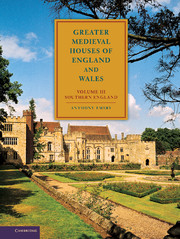Book contents
- Frontmatter
- Contents
- Acknowledgements
- List of abbreviations
- Introduction
- PART I THE THAMES VALLEY
- 1 The Thames Valley: historical background
- 2 The Thames Valley: architectural introduction
- 3 Household expansion, chambers and lodgings
- 4 The Thames Valley: bibliography
- 5 The Thames Valley: survey
- Appendix 1 The Thames Valley castles: residential additionss
- Appendix 2 The Thames Valley: residential licences to crenellate
- PART II LONDON AND SOUTH-EAST ENGLAND
- PART III SOUTH-WEST ENGLAND
- Appendix 5 Castles of south-west England: residential additions
- Appendix 6 South-west England: residential licences to crenellate
- Appendix 7 The architectural value of John Leland and the Buck brothers
- List of plates
- List of figures
- Index
- Index of houses in volumes I, II and III
3 - Household expansion, chambers and lodgings
from PART I - THE THAMES VALLEY
Published online by Cambridge University Press: 05 June 2012
- Frontmatter
- Contents
- Acknowledgements
- List of abbreviations
- Introduction
- PART I THE THAMES VALLEY
- 1 The Thames Valley: historical background
- 2 The Thames Valley: architectural introduction
- 3 Household expansion, chambers and lodgings
- 4 The Thames Valley: bibliography
- 5 The Thames Valley: survey
- Appendix 1 The Thames Valley castles: residential additionss
- Appendix 2 The Thames Valley: residential licences to crenellate
- PART II LONDON AND SOUTH-EAST ENGLAND
- PART III SOUTH-WEST ENGLAND
- Appendix 5 Castles of south-west England: residential additions
- Appendix 6 South-west England: residential licences to crenellate
- Appendix 7 The architectural value of John Leland and the Buck brothers
- List of plates
- List of figures
- Index
- Index of houses in volumes I, II and III
Summary
GREATER HOUSEHOLDS
THE élite households of medieval England were limited to the upper echelons of society, and they were distinguished and clarified by that rapid movement in social mobility that marked the 150 years between the beginning of the Hundred Years' War and the accession of the Tudor dynasty. As discussed in volume II, the gradual definition of the aristocracy from the relatively loose terms used in 1300 and the subsequent expansion of its lower ranks were essentially determined by financial standing.
By the close of the fourteenth century, the number of hereditary peers regularly summoned to parliament had stabilised at about eighty holders. Though new ranks were created such as marquess (1385) and viscount (1440), the number held fairly constant at between eighty to ninety families until the close of that century. To this number should be added the forty leading bishops and high-income ecclesiastics deeply involved in the political life of late medieval England. Landowners with an annual income of more than £40 were expected to take up knighthood, though knights banneret were an enigmatic group who gradually disappeared after the first quarter of the fifteenth century. They were paid a daily rate twice that of a knight, but it was not a hereditary rank, so that holders moved either upwards into the peerage or downwards to the knightly class. The demands of the crown on the battlefield and the growing complexity of administration during the fourteenth century helped to clarify the status of knights as well as the lower one of esquires.
- Type
- Chapter
- Information
- Greater Medieval Houses of England and Wales, 1300–1500 , pp. 27 - 39Publisher: Cambridge University PressPrint publication year: 2006



